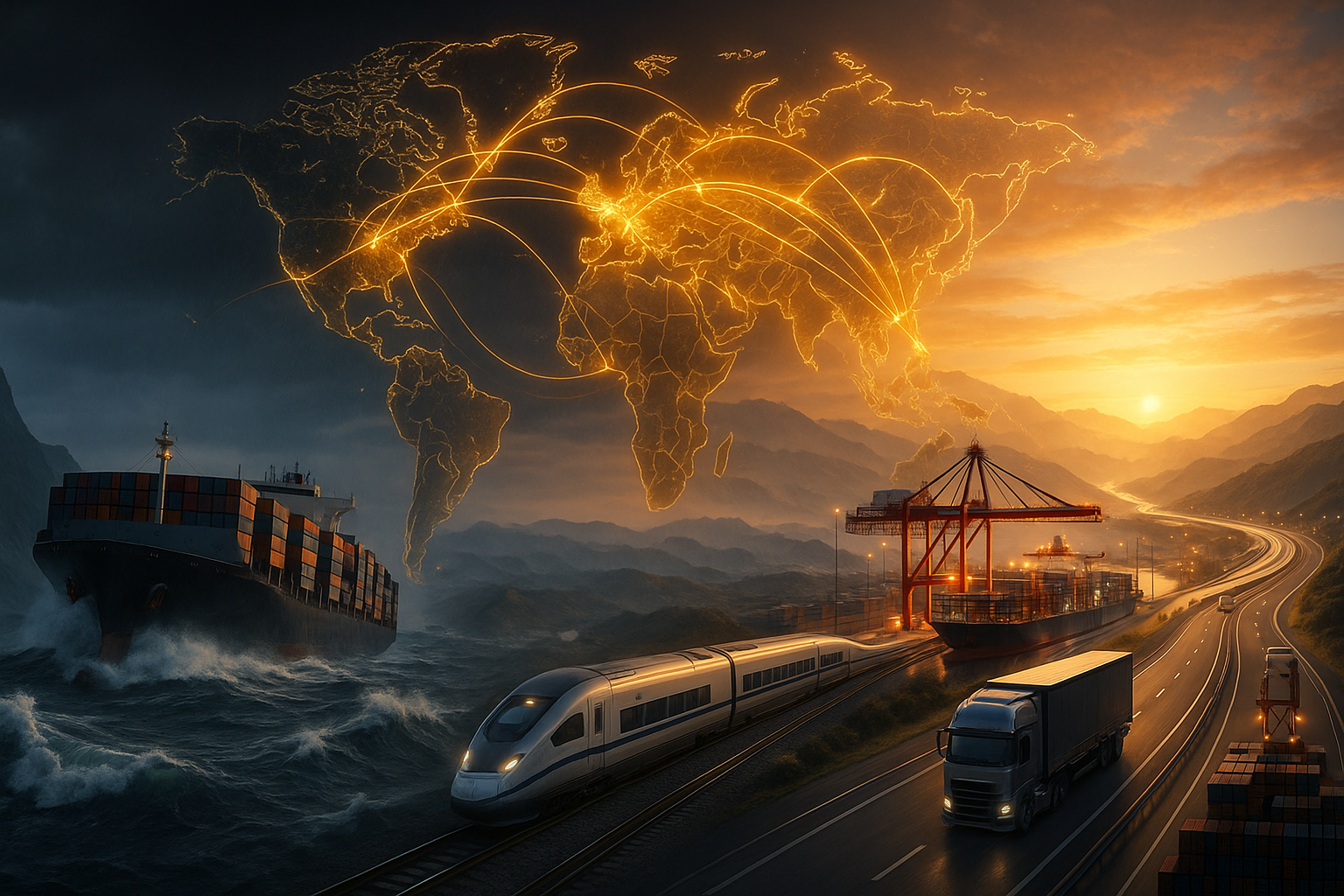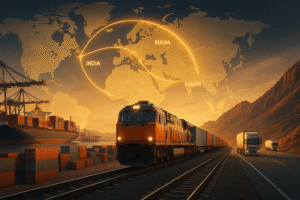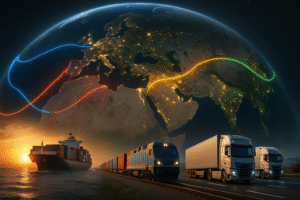
By Arta Rail Research Team
Reviewed by Arta Rail Research Team — September 30, 2025
Snippet:
Red Sea attacks have cut Suez transits ~50%, driving Asia–Europe shippers to seek faster routes. The India–Iran–Russia International North–South Transport Corridor (INSTC) is one contender. This article compares INSTC vs Suez (and other corridors) on transit time, cost, and risks in 2025, assessing if INSTC is the quickest route.
TL;DR:
- Suez bottlenecks: Red Sea conflicts halved 2024 Suez traffic, forcing detours via the Cape (+~10 days on a ~27-day Asia–Europe sail).
- INSTC advantage: India–Europe by INSTC can cut 40–60% of transit time. Trials show Mumbai–Moscow in ~19–23 days vs ~32–37 by all-sea, saving ~$2.5k/15t.
- Key nodes: Bandar Abbas (Persian Gulf) handles ~2.4M TEUs (2024) vs Chabahar’s ~90.8k. The 15Mt/year Rasht–Astara rail link (Iran–Azerbaijan) is under construction, closing INSTC’s last gap.
Suez Canal in 2025 — Bottlenecks and Risks
Geopolitical instability is crippling the Suez route. In 2023–24, repeated Houthi attacks in the Red Sea cut transits roughly in half. By mid-2024, tonnage via Suez fell ~70% while Africa detours surged. To avoid threats, many carriers reroute ships around the Cape of Good Hope, adding about 10 days to an Asia–Europe voyage. For example, a typical Shanghai–Rotterdam liner takes ~27 days via Suez; via the Cape it’s ~37 days.
War-risk insurance has also spiked. As of mid-2025, premiums for Red Sea voyages reached ~0.7% of ship value (up from ~0.3%). This translates to hundreds of thousands in extra cost per shipment.
What this means for shippers:
Longer voyages and rising fuel/insurance costs eat into Suez’s efficiency. The reliability of Africa routings is high, but at the expense of 10+ days and added million-dollar fuel costs. Shippers are increasingly investigating alternate corridors like the INSTC to restore speed and resilience.

Visual representation of the International North–South Transport Corridor (INSTC), combining sea, rail, and road transport between India, Iran, Russia, and Europe.
The INSTC Multimodal Route Explained
The International North–South Transport Corridor (INSTC) is a multimodal India–Europe link via Iran, Azerbaijan and Russia. It combines sea and land legs to bypass vulnerable chokepoints. In broad terms, cargo sails from India to Iran (Persian Gulf or Gulf of Oman ports) and then moves by rail/road north through Iran and the Caucasus to Russia and Europe. Key southern ports are Bandar Abbas (Hormuz) and Chabahar (Oman Sea); northbound by rail to the Caspian Sea (Astara/Anzali) or via Turkmenistan/Kazakhstan to Russia.
Key Ports — Bandar Abbas vs Chabahar
Bandar Abbas (Persian Gulf) is Iran’s busiest container hub. It links by road and rail to Iran’s interior and handles on the order of 37 million tons and ~1 million TEUs annually. In 2024 alone, Persian Gulf ports like Shahid Rajaee (Bandar Abbas complex) saw 2.39M TEUs. By contrast, Chabahar (Oman Sea) is a deepwater port developed with Indian investment to serve Central Asia and Afghanistan. It reached only about 90,800 TEUs in 2024. India’s Shipping Minister Sarbananda Sonowal has praised Chabahar as “a vital trade artery” linking India with Afghanistan and Central Asia, but capacity remains modest.
What this means:
For large-scale throughput, Bandar Abbas currently dominates (more berths, facilities, rail links). Chabahar offers strategic access (bypassing Hormuz) and some EU waivers, yet sanctions risk lingers. Shippers routing to Central Asia/Afghanistan may favor Chabahar, but high-volume Europe-bound cargo often goes via Bandar Abbas for reliability and hinterland links.
Rail/road Segments inside Iran (Rasht–Astara progress)
Inside Iran, the main northbound rail corridor needs one key extension: the Rasht–Astara section (connecting Iran’s Caspian ports to Azerbaijan). This 164km link (under construction) is cited as the final INSTC “missing link.” When complete, officials say it will link Iran’s 11,000+ km network to Azerbaijan, opening capacity for at least 15 million tons per year along the northwest route. Iranian and Russian ministers are expediting Rasht–Astara to unlock that volume. Currently, rail from Bandar Abbas north to Astara is incomplete, requiring some cargo to detour via sea or road.
The impact is already visible: Azerbaijan’s Astara Terminal in Iran handled 777,000 tons in 2024 (up 12% from 2023) and ADY reports 814,000 tons of INSTC transit (up 28%) in 2024. Once Rasht–Astara opens, studies predict corridor capacity may reach 3.5–4 million tons/year.
What this means:
The imminent Rasht–Astara link will vastly improve INSTC throughput to Russia/Europe. Until then, cargo via the Caspian or Iran–Turkmenistan railroad still moves but with extra transshipment steps. For shippers, this means clearance at fewer borders and smoother routes once Rasht–Astara is active.
Transit Times Compared — INSTC vs Suez vs Cape vs IMEC
| Route | Distance | Transit time (one-way) | Cost (relative) |
|---|---|---|---|
| Suez Canal (sea) | ~19,550 km | ~27 days (e.g. China→EU) | Baseline (100%) |
| Cape of Good Hope (sea) | ~26,100 km | ~37 days (+10d vs Suez) | >100% (higher fuel) |
| INSTC via Iran (sea+rail) | ~7,200 km | 19–23 days (Mumbai→Moscow) | ~70% of Suez (30% cheaper) |
| IMEC (conceptual) | - | ~16 days (−40% vs Suez) | ~70% of Suez (30% cheaper) |
Sources: Arta Rail analysis; Reuters; Atlantic Council.
Empirical data highlight INSTC’s speed. Dry-run trials saw Mumbai–Moscow shipments in 19–23 days via Iran versus 32–37 days via Suez. Another test, Mumbai–St. Petersburg, took ~20 days by INSTC instead of 40–60 days by all-sea. By contrast, a Shanghai–Rotterdam voyage is roughly 27 days via Suez and about 37 via the Cape of Good Hope. (The proposed India–Middle East–Europe Corridor (IMEC) is said to cut Suez transit by ~40%, though it’s still in planning.)
What this means:
Time-critical cargo can potentially halve transit time using INSTC. For example, a package that would arrive in ~4 weeks via Suez could reach Europe in ~2 weeks via Iran. IMEC promises similar cuts once operational. Sea-only routes (Suez/Cape) still dominate by capacity but are significantly slower here.
Non-Time Factors Along the INSTC
Tariffs and Costs (rail, road, sea legs)
Transit shipments enjoy tariff advantages: cargo “in transit” through Iran is typically exempt from import/export duties. Iran has cut transit taxes with neighbors – e.g., abolishing a 400% tax on Iran–Uzbekistan trucks and securing exemption of Uzbek transit fees for 2025. This favors goods movement, but port fees and handling still apply. In Iran, transit containers often get discounts (e.g. 25–50% off storage fees).
Freight costs vary by leg. Sea freight from China to Iran runs roughly $1,500–4,550 per container (depending on port). U.S.→Bandar Abbas container rates are about $1,390 for a 20ft load (and ~$1,550 for a 40ft). Inland rail and road tariffs in Iran are modest by comparison, but charges like terminal handling (THC) and cross-border fees apply.
What this means:
Shippers save on customs duties but must plan for port-specific costs. For instance, choosing northern ports (Anzali/Astara) offers Caspian access but different fees than Bandar Abbas. Tools like transparent tariff calculators help; ultimately the cheapest route may depend on load and origin (our cited Arta Rail shipping guide breaks down Iran transit costs).
Customs Clearance, eTIR, and Border Delays
Iran and its neighbors operate under the TIR customs system. In practice, road cargo regularly uses TIR carnets, and Iran leads the world in TIR issuance, which greatly speeds border processing. IRU officials highlight initiatives like “TIR Green Lanes” at Iran’s borders to slash queue times. Crucially, Iran is rolling out eTIR (electronic TIR). IRICA and IRU report that eTIR (UNECE/IRU’s digital platform) will be implemented soon. This replaces paper carnets with an online system, enabling customs offices to process transit cargo remotely.
What this means:
The combination of TIR and eTIR drastically cuts paperwork delays. Instead of stopping at multiple checkpoints, compliant cargo moves with pre-cleared status. Forwarders using the eTIR route should see border dwell times drop, making INSTC shipments more reliable. (By 2025, Iran’s eTIR rollout is expected to align paperwork across its borders.)
Sanctions, Political Risk, and Insurance
International sanctions remain a major consideration. Despite the 2023 Iran nuclear deal, U.S. sanctions still apply to most trade with Iran. The U.S. State Department has warned firms that deals in Iran risk sanctions. Shippers must scrutinize counterparties, vessel flags, and cargo to avoid compliance breaches. Insurance is also a factor: political instability has raised premiums. For example, war-risk insurance in the Red Sea/Gulf region climbed (as noted) to ~0.7% of ship value.
What this means:
Transit via Iran is faster but not without caution. Shippers should factor in higher insurance premiums and strict due diligence. Using reputable carriers (and advisors experienced with Iran) is crucial. If sanctions or insurance costs are a concern, companies may need to seek licenses or consider partial routing through neutral hubs (as we detail on ArtaRail’s customs overview).

Visual comparison of global trade routes showing sea, rail, and road transport along competing corridors such as Suez, Cape of Good Hope, INSTC, and the Turkey land bridge.
Other Competing Corridors
- IMEC (India–Middle East–Europe): A proposed US/EU-backed corridor running India→Gulf (e.g. UAE)→Mediterranean. Early estimates claim it could reduce transit time by ~40% and cost by ~30% versus Suez. But political flashpoints (e.g. Israel-Hamas conflict) have delayed major progress.
- Cape of Good Hope: The classic sea route around Africa. It is fully operational and safe from Middle East conflict, but it is longer — roughly +10 days over Suez — and costs more in fuel. Carriers using the Cape face ~20–30% longer voyages.
- Turkey Land Bridge: Via Iran–Turkey (overland then into Europe). In 2023 Iran and Turkey agreed to boost rail freight to 1 million tons in 2024, by exchanging ~200 wagons daily at Razi–Iran border. This uses standard wagons through the Caucasus and Marmaray rail. It’s a shorter land route to Europe, but still nascent in volume.
No single corridor is perfect. “Middle Corridor” through Azerbaijan/Turkmenistan and Central Asia is another variant (Trans-Caspian routes). For now, IMEC is more conceptual, Cape is proven but slow, and Turkey land routes are growing. Arta Rail’s in-depth Turkey–Caucasus analysis has more on these (see “Iran Transit Hub” and multimodal blog posts).
Expert Views & 2025 Outlook
Experts agree INSTC is gaining momentum. IRU Secretary-General Umberto de Pretto has praised Iran’s transit growth and urged more digital tools: he noted Iran could reduce border congestion by adopting TIR Green Lanes and eTIR. He also said Iran’s transit potential is “even greater” than current flows. UNCTAD points out that ~80% of world trade (by volume) moves by sea, so any Suez disruption has outsized impact. Logistics media (e.g. RailFreight, JOC) have documented expanding India–Russia and India–Europe cargo via Iran. Our data confirms this: India–Russia freight via INSTC has roughly doubled in recent years as shippers exploit shorter times.
What this means for forwarders:
The consensus is clear – INSTC can unlock faster schedules and cost savings if managed properly. Traditional reliance on Suez may leave shippers exposed. As one forwarder put it, “in 2025 it’s frankly puzzling how many companies still rely solely on the Suez!”. Forwarders should study regional logistics in detail. Arta Rail’s own analysis and route maps (e.g. our Iran as Transit Hub and INSTC route analysis) offer customs, border, and network insights that go beyond headlines.
Conclusion
INSTC via Iran is not a silver bullet but a serious Suez alternative in 2025. By combining sea and land legs, it offers India–Europe transit times ~30–50% shorter than all-sea routes, often at lower cost. However, non-time factors (sanctions, border processing, insurance) remain critical. Shippers must weigh the faster schedules against these risks. As of Sept 30, 2025 the data above is up-to-date; for live developments see the Arta Rail Blog.
For more on regional rail and logistics: See Arta Rail’s posts on INSTC logisticsChina–Europe rail times.
Author Bio:
The Arta Rail Research Team specializes in rail freight, logistics innovation, and multimodal trade through Iran. With deep expertise in INSTC, customs procedures, and infrastructure analysis, the team delivers actionable insights for shippers and forwarders navigating Eurasian corridors.
